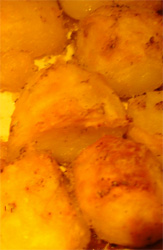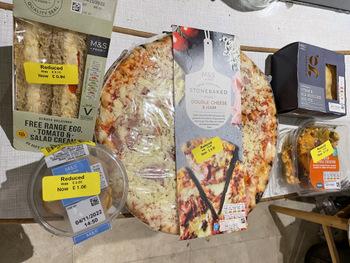Sunday Roast: How To Make Perfect Crispy Roast Potatoes in Goose Fat recipe
Posted by Fiona Nevile in Vegetables and Sides | 38 comments Good potatoes make decent roast potatoes. Great crispy roast potatoes are cooked in goose fat. We discovered this when we had a surfeit of goose fat knocking about in the fridge. Until a month ago, I used to feel a bit guilty about using goose fat. Even so, I secretly looked forward to the highlight of the Sunday roast – crisp, soft centred, irresistible, golden roast potatoes.
Good potatoes make decent roast potatoes. Great crispy roast potatoes are cooked in goose fat. We discovered this when we had a surfeit of goose fat knocking about in the fridge. Until a month ago, I used to feel a bit guilty about using goose fat. Even so, I secretly looked forward to the highlight of the Sunday roast – crisp, soft centred, irresistible, golden roast potatoes.
Imagine my delight last month when I discovered that goose fat is the healthiest of animal fats. It’s high in healthy mono and polyunsaturated fatty acids and low in saturated fats.
Until I met Danny I wasn’t really interested in potatoes. I particularly liked those tiny expensive Jersey Royals. When these were out of season, I didn’t eat potatoes. If friends were coming for lunch I’d buy a bag and throw out the slimy remains a few weeks later.
Danny’s arrival heralded a change in diet. He was very patient, enduring months of sprouting mystery “white potatoes” that I bought in large paper sacks. They were excellent value as they lasted for weeks. Finally he tentatively suggested that we might buy a small bag of King Edwards for a Sunday roast. The 5 kilo bag was devoured within a couple of days.
Suitably chastened, I now grow our own and supplement these with the best available locally. Yet the secret of great roasties owes more to the fat than the potatoes.
Recipe for Perfect Roast Potatoes (for four – they will eat more of these than you might imagine!)
Pre-heat oven to 210c (190c fan, gas mark 6)
Ingredients:
- 1 kilo potatoes (King Edward, Desiree, Kerrs Pinks are best but any will do. The fresher the better)
- 2 tbsp goose fat
- half tsp garlic granules
- 1 tsp salt
- 2 tsp ground black pepper
Method:
- Boil a large kettle of water, enough to cover the potatoes when they will eventually be in your saucepan
- Wash and peel the potatoes and cut into similar sized pieces (leave smaller potatoes whole or cut them in half and then match this chunk size when chopping the bigger ones)
- Place potatoes in a large saucepan and cover with boiling water. Parboil them by bringing them back to the boil and then boil gently for no more than ten minutes.
- Turn off the ring
- Put the goose fat into a large shallow oven-proof dish (or roasting tray) and put on top shelf of oven to melt and heat through
- Strain potatoes and return to the saucepan. Place the saucepan back onto the still-warm ring for about five minutes, shaking it every now and then to break down the edges of the potatoes, making them dry and fluffy.
- Remove the dish from the oven and sprinkle the salt, pepper and garlic granules fairly evenly over the goose fat.
- Carefully tip the parboiled potatoes into the dish so as to avoid splashing the hot fat over you. Turn them over and over until they are coated in the fat, salt, pepper and garlic mix.
- Return the dish to the top shelf of the oven for one hour, turning the potatoes half way through.
Tips and tricks:
- Try to time the roast potatoes so that they are ready just as you are about to serve the meal, to enjoy them at their crispiest.
- If your joint requires a lower cooking temperature you can still follow the method above. Just put them in half an hour before your joint is due to be taken out and then turn the oven up to 220c (200c fan) for the last half an hour whilst your joint is relaxing under a keep-warm duvet of foil covered with tea cloths.
- These potatoes need an hour in the oven. Anything less does not work.
- French goose fat in jars is available from Waitrose (in the butter and fat area). Store in your fridge. I’ve also seen tins of goose fat in Sainsbury’s at Christmas.
- Goose fat can be reused. Pour into a seperate container and store in the fridge, it keeps for quite a while.
- If we eat goose for Christmas lunch we save the fat and freeze quite a bit in cubes.
Leave a reply






When you said perfect roasties, you weren’t joking… I just made these for Christmas dinner and my partner and I both agree that they’re the best roasties we’ve ever tasted. So I’m doing them again for Hogmanay! Thank you so much for this recipe.
Morning,
Aggie from (how clean is your house fame) swears by goose fat for making her sweet pastry for mince pies, have kept the article, shall have to find it out amongst my many ‘cuttings’ from magazines and will post recipie, when I find it!
Oh how I wish I wasn’t such a hoader!…..LOL
It does come in handy sometimes though, well that’s my excuse.
Lv Odelle X
this really helped me with my school work ! 🙂
My mother always cooked her roast veggies in dripping. Unfortunately, it’s not only becoming expensive (last time I bought it I had to pay somewhere between 3 and 4 dollars a half kilo for what cost $1.99 not long ago) but is also hard to find. I can understand the former problem (with so many of New Zealand’s beef and sheep farms being shoved into dairy production, the price of beef and lamb/mutton are naturally going to rise) but I’ve no idea why I’m having trouble finding it. With the stupid medical profession urging us to use oil and to eat that horrid chemical concoction with a texture like axle grease instead of butter, there shouldn’t be a shortage of dripping because not many people will be using it. My goose fat, BTW, cost me about $8.50 for a jar that (I think) has about 320g in it.
Hello Andrew
Danny worked for years developing the perfect recipe – his beef roasts are always excellent. BTW he is really chuffed by your comment!
Hi Laraine
We’ve never tried roasting spuds in dripping – must give that a go – thanks for the tip!
My roast potatoes were lovely too, but I can’t honestly say I find the extra I spent on buying goose fat made the potatoes any nicer than when I cook them in my usual fat (dripping). So when I’ve finished the goose fat I bought I won’t be buying any more.
Danny – I followed your advice regarding the roasting of beef, even to the detail of the carrot stock for gravy. Yummy – I’ve never tasted such tender beef; we were all very well surprised, thanks. The size of the beef was a bit large however, 1.8 kg. Although I put it in a hot oven [gas mark 9] for 20 minutes and then turned the oven down to Mark 4 for the prescribed time, I didn’t get the blackened outer surface. Next time I’ll try increasing the initial phase if the joint is that size and see what results.
However, I am so encouraged and delighted. The basting in olive oil and seasoning with no aluminum foil covering clearly works so well, with the foil holding the juice close to the joint. 🙂
This website is a great resource, many thanks. Andrew
Thanks Fiona and Danny – your help is much appreciated and I will go to work on this later. Danny, when it comes to slicing the beef, how thick do you like it and how do you best achieve that?
All the best to you for 2010